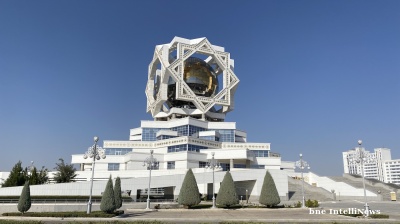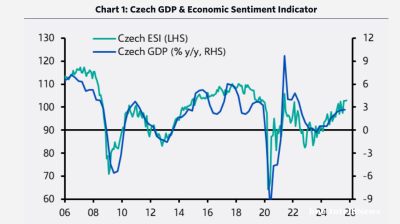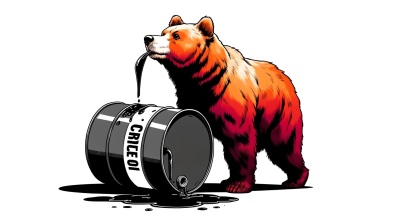Wages are starting to grow again in Russia after several years of shrinkage, leading economists to hope that consumption will return as an economic driver in the second half of this year. However, drilling into the distribution of wages, the recovery is clearly very mixed.
The two mega-cities of Moscow and St Petersburg both had incomes that are 51% and 117% more than the average national wage of RUB42,640 ($625) per month as of July, according to Rosstat, however, as the chart shows, about two-thirds of Russian regions have incomes well below that level.
In general the poorest regions with incomes under RUB30,000 per month are all along Russia’s southern boarder, with the Republic of Chechnya coming in last place with an average income of RUB26,116 ($383) — just under half the national average.

Surprisingly Moscow is not the richest city in Russia in terms of income, although it ranks in the top five. That honour goes to Chukotka, a mining outpost in the extreme Far East and Far North corner of the country. The reason for Chukotka’s high score is almost certainly that its former governor Roman Abramovich is registered there and pays his personal income taxes in his “home” region. As a one time richest man in Russia, Abramovich’s personal income tax payments used to make up half the region’s income and have clearly driven the regional average score up.
St Petersburg also scores well with an average income of RUB62,619 per month, but again, against the national average this remains relatively modest.
The other high scoring regions are all in the wastes of Siberia and Yakutiya – the mining and oil and gas producing regions. Wages in these regions are deceptively high, but as they are all almost entirely cut off from the rest of the country, without road or rail links, the locals talk as if they live on an island and refer to the rest of Russia as “the mainland” – everything has to be flown into cities such as Sakha (diamond mines) or Nenets (oil), making the cost of living twice that in the rest of the country.
Taking these factors into account, Moscow and St Petersburg emerge as by far the best off cities in Russia to live. The raw material producing cities may have better pay, but the quality of life is probably much closer to the average income levels once the cost of living is accounted for. (And that assumes you have a job with the local mining companies; pensioners trapped in these regions because they can’t sell their apartments are in a very difficult position.) Meanwhile, those that live along the southern periphery are in a much worse position than their peers in the European part of Russia.
As part of President Vladimir Putin’s May Decrees, the president has called for the rate of poverty to be reduced and the number of small and medium-sized enterprises (SMEs) to be increased to provide more employment.
And the growth of real wages and disposable income growth remained robust in July, with real wages up 8%, accelerating from 7.2% in June. Thanks to the success of the Central Bank of Russia (CBR) campaign to drive down inflation to record lows – consumer price inflation (CPI) was about 3% in August – Russians are starting to feel the benefit in their pocket: real disposable incomes grew 2% y/y in July versus 0.7% y/y in June.
"This improvement [in wages] reflects low headline inflation, limited indexation of utilities in July, the favourable base effect and conditions for the tradable sector profitability," VTB Capital said in a note.
The average monthly salary of employees in July was RUB42,640, which is 10.7% more than in July last year, according to Rosstat, while in the first half of the year, the average monthly salary increased by 11.1% compared to the same period in 2017.
But the distribution of income in the regions is worrying as it shows a large part of the population – maybe even the majority – is not feeling the benefits of this wage growth and remains poor. The government’s failure to improve the business environment to the point where SMEs can flourish prevents those at the bottom of the ladder from improving their lot. As the high wages are concentrated in the wilds of the tundra the increases are accruing to the regions with large state-owned companies or raw material producers, but which are also sparely populated, distorting the numbers.
Some 80% of Russia’s population live in the European part of Russia and according to Rosstat’s figures for June the average income in the Volga Federal district was RUB31,571.
Even the Central Federal District (that contains Moscow) doesn't do much better and if you count out Moscow City and the Moscow Region’s income, the regional average falls to RUB32,145 per month.
|
Average income by federal district RUB/month |
|
|
Central Federal district |
36,571 |
|
North west Federal district |
49,153 |
|
Southern Federal district |
32,265 |
|
North-Caucasian Federal District |
28,416 |
|
Volga Federal District |
31,571 |
|
Urals Federal District |
57,067 |
|
Siberian Federal District |
40,108 |
|
Far Eastern Federal District |
60,083 |
|
Source: Rosstat |
|
Clearly a large part of the population are not feeling the benefits of the slow economic recovery. What worries analysts (and increasingly the CBR) is that retail loans have taken off in the last year and it is not clear what is driving the acceleration of borrowing.
On the one hand the improving economic outlook and, even more importantly, the falling cost of borrowing mean regular Russians are leveraging their incomes to go shopping. It will be interesting to see what happens to consumer loans in the rest of the year after the summer’s geopolitical fears that the US will impose new “crushing” sanctions this autumn led to a 17% devaluation of the ruble and rising inflation, and has probably ended the CBR’s loosening cycle.
But as many of these loans are being taken out by Russians in the hinterland, analysts worry that increasingly Russians are struggling to make ends meet and so are simply borrowing their way out of trouble to maintain their standard of living.
Features

Slovenian consumers take energy giant GEN-I to court over price hikes
The Slovene Consumers’ Association accused GEN-I of unlawfully raising household prices at the height of the recent energy crisis.

Indonesia's $12bn stimulus play
The coordination between the Finance Ministry and the presidency signals tighter executive cohesion under President Prabowo’s leadership, contrasting with the cautious fiscal stance of prior administrations.

COMMENT: For Asia, dealing with Europe isn’t about achieving success; it’s about concealing failure
To be taken seriously in Asia, Europe must rediscover the courage to deliver, not merely declare. Asia has moved on to execution. Europe is still editing its initial policy draft.

Washington has a new focus on a Caspian energy play
For most of the last three decades since winning independence, Central Asia has been a bit of a backwater. Not any more. The Trump administration is becoming more focused on Turkmenistan's vast gas reserves and can smell money and power there.




